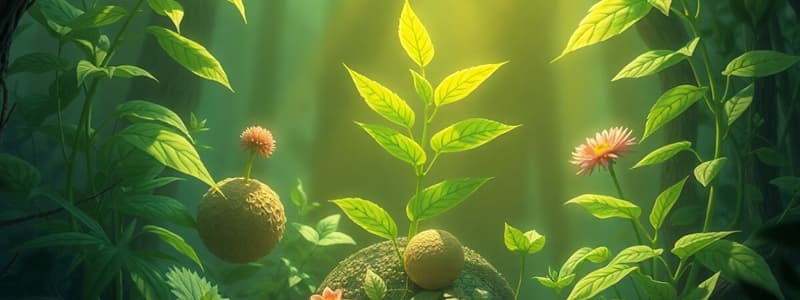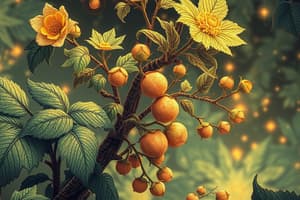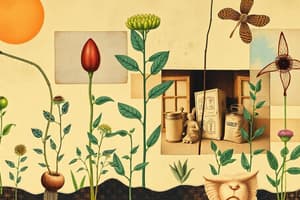Podcast
Questions and Answers
The components of food are called ______ and are necessary for our body.
The components of food are called ______ and are necessary for our body.
nutrients
Plants are called ______ because they can produce their own food.
Plants are called ______ because they can produce their own food.
autotrophs
Animals and most other organisms that obtain food from plants are called ______.
Animals and most other organisms that obtain food from plants are called ______.
heterotrophs
[Blank] are the food factories of plants.
[Blank] are the food factories of plants.
The green pigment present in leaves is called ______.
The green pigment present in leaves is called ______.
The process by which plants synthesize food using sunlight is called ______.
The process by which plants synthesize food using sunlight is called ______.
[Blank] is the ultimate source of energy for all living organisms.
[Blank] is the ultimate source of energy for all living organisms.
The tiny pores on the surface of leaves through which gases exchange are called ______.
The tiny pores on the surface of leaves through which gases exchange are called ______.
Plants synthesize ______ through the process of photosynthesis.
Plants synthesize ______ through the process of photosynthesis.
Organisms that grow in ponds or stagnant water bodies are called ______.
Organisms that grow in ponds or stagnant water bodies are called ______.
The plant that has a heterotrophic mode of nutrition and climbs on other plants is called ______.
The plant that has a heterotrophic mode of nutrition and climbs on other plants is called ______.
The plant on which cuscuta climbs is known as the ______.
The plant on which cuscuta climbs is known as the ______.
Insect-eating plants are called ______ plants.
Insect-eating plants are called ______ plants.
Organisms that derive nutrition from dead and decaying matter are called ______.
Organisms that derive nutrition from dead and decaying matter are called ______.
The relationship where two organisms live together and share shelter and nutrients called ______.
The relationship where two organisms live together and share shelter and nutrients called ______.
Flashcards
What are nutrients?
What are nutrients?
Components of food that are necessary for our body.
What is autotrophic nutrition?
What is autotrophic nutrition?
The mode of nutrition where organisms make their own food from simple substances.
What are heterotrophs?
What are heterotrophs?
Organisms that obtain food from other plants and animals.
What is a cell membrane?
What is a cell membrane?
Signup and view all the flashcards
What is the nucleus?
What is the nucleus?
Signup and view all the flashcards
What is cytoplasm?
What is cytoplasm?
Signup and view all the flashcards
What are stomata?
What are stomata?
Signup and view all the flashcards
What is chlorophyll?
What is chlorophyll?
Signup and view all the flashcards
What is photosynthesis?
What is photosynthesis?
Signup and view all the flashcards
What are saprotrophs?
What are saprotrophs?
Signup and view all the flashcards
What is saprotrophic nutrition?
What is saprotrophic nutrition?
Signup and view all the flashcards
What is symbiosis?
What is symbiosis?
Signup and view all the flashcards
What are lichens?
What are lichens?
Signup and view all the flashcards
What is Rhizobium?
What is Rhizobium?
Signup and view all the flashcards
What is parasite plants?
What is parasite plants?
Signup and view all the flashcards
Study Notes
- Food is essential for all living organisms
- Carbohydrates, proteins, fats, vitamins, and minerals are components of food
- These components are called nutrients, which are necessary for the body
- All living organisms need food
- Plants can create their own food
- Animals, including humans, cannot create their own food
- Animals get food from eating plants or animals that eat plants
- Therefore, humans and animals rely directly or indirectly on plants
Mode of Nutrition in Plants
- Only plants can prepare food for themselves
- Plants use water, carbon dioxide, and minerals
- Raw materials are present in the surroundings of the plants
- Nutrients help living organisms build their bodies, grow, repair damaged parts, and provide energy
- Nutrition is how an organism takes food and uses it
- Autotrophic nutrition is when organisms make their own food from simple substances (auto = self; trophos = nourishment)
- Plants are autotrophs
- Heterotrophs consume food prepared by plants (heteros = other)
- Animals and most other organisms are heterotrophs
Photosynthesis – Food Making Process in Plants
- Leaves are the food factories of plants
- Raw materials must reach the leaf
- Roots absorb water and minerals from the soil
- Water and minerals from the soil are transported to the leaves
- Carbon dioxide from the air enters through tiny pores on the surface of leaves
- Stomata are pores surrounded by guard cells
Cells
- Cells are the tiny units that make up living organisms
- Cells can only be seen with a microscope
- Some organisms are made of only one cell
- Cell membrane encloses the cell's outer boundary
- Nucleus is the distinct, centrally located, spherical structure that most cells have
- Cytoplasm is the jelly-like substance surrounding the nucleus
- Chlorophyll is the green pigment in leaves
- Chlorophyll captures the energy of sunlight
- This energy is used to synthesize food from carbon dioxide and water
- Photosynthesis is the synthesis of food in the presence of sunlight (Photo: light; synthesis: to combine)
- Chlorophyll, sunlight, carbon dioxide, and water are necessary for photosynthesis
- Photosynthesis is a unique process
- Solar energy is captured and stored as food in plants
- The sun is the ultimate source of energy for all living organisms
- Life on Earth would not be possible in the absence of photosynthesis
- The survival of almost all living organisms depends on the food made by plants
- Oxygen is essential for survival
- The oxygen is produced during photosynthesis
- Photosynthesis also occurs in green stems and branches
- Desert plants have scale- or spine-like leaves to reduce water loss via transpiration
- Desert plants have green stems that carry out photosynthesis
- Life would be impossible on Earth without photosynthesis
- During photosynthesis, chlorophyll-containing cells of leaves use sunlight to synthesize carbohydrates from carbon dioxide and water
- Oxygen is released during the process of photosynthesis
- Presence of starch in leaves indicates photosynthesis occurred
- Starch is also a carbohydrate
Other Modes of Nutrition in Plants
- Some plants don't have chlorophyll and cannot synthesize food
- The plants depend on food produced by other plants
- Heterotrophic nutrition is utilized by these plants
- Cuscuta (Amarbel) is a plant lacking chlorophyll with a yellow, wiry, branched structure
- Cuscuta takes readymade food from the host plant that it climbs on
- The host is deprived of valuable nutrients by the Cuscuta plant, which is called a parasite
- Insectivorous plants trap and digest insects
- Insectivorous plants may be green or other colors
- The Pitcher plant is a plant with a pitcher-like structure modified from a leaf
- The apex of the leaf forms a lid that can open and close
- Hairs directed downwards inside the pitcher entangle insects that land inside
- Digestive juices secreted in the pitcher digest the insects and their nutrients are absorbed
Saprotrophs
- Packets of mushrooms are sold in the vegetable market
- Fluffy umbrella-like patches that grow in moist soil or on rotting wood during the rainy season
- Fungi are organisms which get nutrition from dead, decaying matter
- Saprotrophic nutrition is where organisms get nutrients from dead and decaying matter
- Saprotrophs are organisms with saprotrophic nutrition
- Fungi also grow on pickles, leather, clothes, and other items left in hot and humid weather
- Menace of fungi in the house occurs during the rainy season
- Fungal spores are generally present in the air
How Nutrients are Replenished in the Soil
- Farmers spread manure or fertilizers in fields; gardeners use them in lawns or pots
- Plants absorb minerals and nutrients from the soil, depleting the amounts in the soil
- Soil loses nutrients as plants absorb them
- Fertilizers and manures add nutrients like nitrogen, potassium, and phosphorus to the soil
- Nutrients need to be added to enrich the soil and ensure plants grow and stay healthy
- Crop plants absorb a lot of nitrogen, causing the soil to become nitrogen deficient
- Nitrogen gas is abundant in the air, but plants can't use it directly like carbon dioxide
- Nitrogen is needed in a soluble form
- Rhizobium bacterium converts atmospheric nitrogen into a usable form
- Rhizobium can not make its own food
- Rhizobium lives in the roots of gram, peas, moong, beans, and other legumes and provides them with nitrogen
- This symbiotic relationship greatly benefits farmers
- Symbiotic relationship reduces the need for nitrogenous fertilizer in leguminous plants
- Pulses (dals) come mostly from leguminous plants
- Most plants are autotrophs, a few are parasitic or saprotrophic, deriving nutrition from other organisms
- All animals are heterotrophs, depending on plants and other animals for food
- Insectivorous plants are partial heterotrophs
Studying That Suits You
Use AI to generate personalized quizzes and flashcards to suit your learning preferences.




